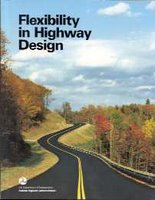Trinitarian Highway Design

This might be my first post on engineering if my memory hasn't failed me somewhere; which is exciting for me, even if it has been a long time coming.
My short civil engineering experience in Bozeman has proven to be one where practicality and common sense go much further than most of the formulas in my Fluid Mechanics book; not to say that that book hasn't been extremely useful at times already. It seems that when the theoretical design must find its place somewhere in the real world (when and where the rubber meets the road, so to speak), strict adherence to mathematical calculations isn't always enough, and isn't always successful.
Today I attended my first day of the Spring Engineering Festival held at the Montana State University Campus. My first session was specifically given on the "Interactive Highway Safety Design Model" (IHSDM); software that has been developed from a government funded agency to develop another useful tool for designing safer highways in our country. There are a number of factors that come into play when evaluating how "safe" a roadway is: steepness of grades, design speeds, stopping sight distances, radius of curves, accident history, volume of cars, to name a few. But, one factor that was emphasized to my surprise was human perception; and out the window went any possible argument for relativism.
Our presenter showed us a picture of a windy road through a town and asked us to assess the safety of the roadway and how we might gather data to make an evaluation on it. Finally, the presenter asked if we could see the house on the corner, "What about knocking on the door and asking the people who live there what they think about the safety of the road?" He went on to emphasize that even if a road has a low accident history, people may still perceive that the roadway is unsafe, and a very real problem may still exist.
The presenter later quoted a high-level design engineer who made the following statement: "The direct application of established design criteria or standards (i.e., nominal safety) is no assurance that a certain quality of design (i.e., level of substantive safety) will be achieved -- indicating that such criteria are not sufficient in themselves." "Nominal safety" is based on a pass fail system; a roadway either meets safety policies and design codes or it doesn't. "Substantive safety" is based on expected crash ratings and how this relates to other similar roadways or other ratings in the area; it is a grayer shade of measurement, but just as important.
Now, at least two ethical and economical issues present themselves. First, say a roadway meets all state road design policies and codes, but has a high accident history? Do you spend the money to improve the safety of the road even though there is no law requiring it? Second, say a roadway has a low accident rating and performs well, but isn't up to state design code. Do we "waste" money to bring a well-functioning road up to code?
How do we quantify safety? How much weight should safety have in relation to financial and property issues?
I really believe that the IHSDM seeks to provide a tool that helps engineers compare, more efficiently, other wordly factors that are not quite so mathematically measurable, such as demographic factors: weather, number of animals on the roadway, average age of drivers on the roadway, and types of vehicles on the roadway to name a few. What I so thoroughly appreciated here was the understanding of the relationships between all of these factors and the effects they have on drivers, and also the compounding effects factors have on each other.
The presenter went on to admit that every model can seek to explain the effects of specific elements on a design, but they always break down when you try to explain how the interaction of these elements with each other effect the design -- and yet, this is crucial to the actual performance of the roadway! Most drivers don't drive the speed limit, how does this effect the danger presented by sharp corners? How does Fall effect the number of deer on the road? How will a driver perceive the road ahead in light of the road he has just traveled? How does a highway patrolman effect the flow rate of a highway?
Now, if you are still reading after all of the engineering mumbo jumbo, I will try to explain what was so encouraging about this session. First, I was chest deep into a theoretical science that was seeking to expand itself into realms that were more relational than quantifiable and still using that for design criteria. The bartender on main street could offer his opinion on the efficiency of the traffic light system on main street, and it would be taken into account. We had to assume that the safety of people's lives are very much our responsibility, and to successfully carry out the duty of protecting them we need to better understand the relationships between people and creation and how different elements in creation effect each other. The task is daunting, overwhelming in the least, and yet exciting at the same time. At this stage it is still messy, but there was a glorious element to it.
Through sanctification God takes what is corrupted and begins to perfect it, ultimately bringing it to perfection. We play an active role in this process. We actively seek to rid ourselves of sin and live more faithfully, knowing that we will still never reach perfection till the return of our Savior. The discussion of highway design today was seeking to better model and understand the relationships between people and nature in order to better design safer and more effective roadways. We will never reach perfection in highway design this side of Redemption, but we strive for it anyway.
I wonder how much more efficient our progress we would be if we began to research these relationships knowing that a Triune God has designed them?


2 Comments:
I thoroughly enjoyed the post, even the tidbits of "engineering mumbo jumbo", which it was hardly.
The whole aspect of combining science/math with the personal input from people lines up with a thought from today.
Story is important, but incomplete. Math is important, but incomplete. Just as building a road based purely on input from the barber would be foolish, so to is building a road based purely on calculations foolish. The barber (story) and calculations (math) both attempt to describe relationships, both attempt to relate reality, but both fail on their own. They were designed to work together.
God made the world and it reflects him. The one true reality is not described by just one set of means. We need story, math, etc. because Allah didn't create the world, the Triune God did.
This is also why we should strive to be truly "educated" and partly why the public education system fails.
Like Charlie, I too enjoyed the post. Is there such as thing as engineering mumbo jumbo? I think not.
I agreed with your last paragraph, but I'm not sure I agreed with much else, for a few reasons.
First, those proposing the "new" approach to highway design are not seeking to do so from a Trinitarian bent; so I'm leary from the get go. The attempt at incorporating the relational aspect into the design I believe is feigned. I'm assuming the input from the locals perceived safety of the roadway will result in a less economical design. When the rubber meets the road (hehe) a less economical design will probably not be utilized. Your input is important Mrs. Smith, but not really. Highway design is largely under the jurisdiction of public agencies, who are in the business of making the public feel like they are concerned about their welfare, but really are not.
Secondly, what the "new" design approach neglects to understand is that the principles, equations, and calculations governing highway design are not purely mathematical. They have been derived over the years largely based on, guess what, driver comfort and experience. In response to a comment in the post, most roads are now designed for a speed 10 mph greater than the posted speed limit. So this isn't really a "new" design approach. I fear it may just be the outworking of the bloated importance our generation/society has bestowed upon themselves. Of course, as Christians know, there is always room for sanctification (i.e. getting better). However, I don't believe the attitude of those proposing the "new" design method to be as one standing on the shoulders of those who have gone before.
Lastly, "safety" has been bastardized in recent years to unrealistic levels. Currently, a company our firm has a close relationship with (which I will refer to only as CPAI) has implemented a "Zero Incident Culture" program in all their dealings. The aim is to produce a workplace or jobsite so safe that accidents cannot and will not occur. Of course, they recognize that is imposssible, but keep striving to stifle productivity with unnecessary safety precautions anyway. In light of today's orgy fest of lawsuits, I think the company is actually seeking to shift their responsibiity to their workers onto their workers, not specifically protect them. Their practice is not altogether uncommon now, and it is done all in the name of "safety".
Where does ultimate safety come from? If the goal is to design roads so benign no one could possibly get hurt, we are mocking God. If we are designing roads that seek to eliminate all personal responsibility, we are mocking God. We must realize our limitations on providing safety apart from a God who keeps His promises.
Post a Comment
<< Home